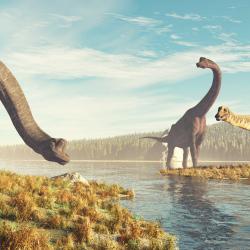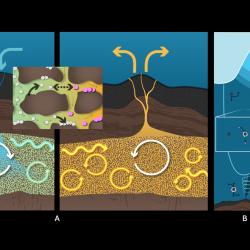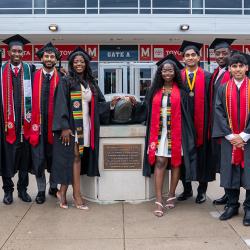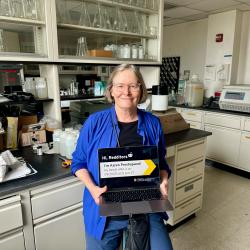Geology Principal Lecturer Thomas Holtz Answers Questions About Dinosaurs
The College of Computer, Mathematical, and Natural Sciences hosted a Reddit Ask-Me-Anything spotlighting paleobiology research.

University of Maryland Geology Principal Lecturer Thomas Holtz participated in an Ask-Me-Anything (AMA) user-led discussion on Reddit to answer questions about dinosaurs on May 28, 2025.
Holtz’s research focuses on the evolution, functional morphology, biomechanics, and adaptive trends of major groups of extinct vertebrates, especially Tyrannosaurus rex and its closest dinosaur relatives. He also examines how the ecological niches of dinosaurs changed during their life history and how that is reflected in the overall community structure of their environments.
This Reddit AMA has been edited for length and clarity.
What is your favorite dinosaur?
This one is easy! Tyrannosaurus rex has always been my favorite dinosaur, and it always will be. When I was 3 years old, I decided I was going to grow up to be a dinosaur; and if you're going to be a dinosaur, you might as well be the king.
What contribution to the field have you made that you are most proud of?
In my early days, one of my big contributions was figuring out where tyrannosaurs fit into the family tree of carnivorous dinosaurs. More recently, I’ve been proud of my work on the changing role of different dinosaurs as they grew up from hatchlings to adults.
Do you plan on releasing any new books or an update to your 2007 book, “Dinosaurs: The Most Complete, Up-to-Date Encyclopedia for Dinosaur Lovers of All Ages?”
I do plan to revise the 2007 book. But that's on the back burner for now. There is a new edition of my 2012 book "The Complete Dinosaur" that we need to wrap up soon. Also, I have a kids' book on T. rex already written, but its publication fate is a bit misty right now.
Thanks for the encyclopedia that rocked my childhood! Are there any clues or hypotheses about how abelisaurids and megaraptorans in late Cretaceous South America (two morphologically very different groups) interacted or divided prey between them?
Given the radically different anatomy of the two (short snouts and stubby arms in the abelisaurs and long, slender snouts and enormous claws in megaraptorans), they clearly hunted in different fashions. But we don't yet know if they partitioned their prey.
As both a scientist and an educator, where do you devote the most effort: new niche information relevant to a few specialists (academic science) or well-established but broadly misunderstood information relevant to most people (popular science)? What's your advice for finding the balance between these extremes?
Actually, I have to deal with both sorts of cases. We do have to deal with persistent cases of misinformation, but trying to get the news out about new discoveries is important so that people aren't stuck in old understandings and old mindsets. In finding how to pitch information, you need to listen to what people are talking about to determine what they already understand or misunderstand. But this is a dynamic situation, and so there is no one solution that fits all issues.
For example, you need to know which audience you're talking to. For some people, the fact that birds are a type of dinosaur is brand new information, so you need to focus on the evidence about that. But for those who are more familiar with paleontology, you can do a deeper dive into particular hypotheses concerning the origin of bird flight or which particular forms of feathered dinosaur may have been capable of aerial locomotion.
How accurate is today's general depiction of dinosaurs in terms of their general appearance and sound?
Unfortunately, we don't know what's on the outside of most dinosaurs. There are some cases where we can see the presence of fuzz or feathers or scales, and in rarer cases, we can see some evidence of what colors those were. But for most species of dinosaurs, we don't have that information, and so we have to infer from their closer relatives, but we almost certainly are wrong about specific things like colors and patterns.
As far as sound, there are a few types of dinosaurs for which there is some evidence of their sound-generating organs, so we can get a sense of the types of sounds they might make. But knowing that a tube-crested hadrosaur could make sounds like a bassoon doesn't tell you the sounds it would sing.
What do you think has been the biggest change in a previously understood dinosaur fact? And what is the biggest debate in the dinosaur world currently?
I would say the biggest changes to dinosaur paleontology over the past 50 years are the recognition that most or all dinosaurs were warm-blooded, and that birds are the living part of the dinosaur family tree.
Among the biggest current debates are the relationships at the base of the dinosaur family tree: exactly who is and who isn't a dinosaur and who is each other's closest cousins. For instance, are Silesaurs (Triassic herbivorous Archosaurs) dinosaurs or dinosaurs' closest relatives?
How small can a *true* tyrannosauroid be?
Some of the early Tyrannosauroids would be smaller than an adult human, but because they are more closely related to Tyrannosaurus itself than to the other major branches of carnivorous dinosaurs, they would be true Tyrannosauroids.
What was it that solidified the evolution from tyrannosaur to bird? For example, if seen in the flesh, what would make you say that’s a bird, not a dinosaur?
To be fair, birds did not come directly from tyrannosaurs. Also, all birds are a type of dinosaur, not a separate category, just like all bats are mammals. You are right, though, had some of the raptor dinosaurs survived to modern times, we probably would call them a type of bird. The origin of birds was not a single instant, but was a series of transitions within the carnivorous dinosaur family tree. Saying something is a bird is ultimately an arbitrary decision, rather than a scientific one.
What is your favourite Tyrannosaurus specimen, and why?
My favorite specimens are Sue at the Field Museum in Chicago, IL, and Jane at the Burpee Museum in Rockford, IL. They represent end members of what it was like to be a Tyrannosaurus—a bone-crushing bruiser and a ballerina of doom, respectively.
What made you interested in the arctometatarsus and the initial tyrannosaur-coelurosaur hypothesis?
Graduate students are expected to find a narrow problem to investigate that might have broader implications. Although others had already noted the similarity of the feet of ornithomimids, tyrannosaurids, troodontids, and a few other groups, there had been little work done then trying to investigate the functional implications of this structure and its evolutionary implications. Or, for that matter, even naming that feature! I was able to coin the name "arctometatarsus" (actually, I first coined the adjective version, "arctometatarsalian") and looked at its morphometrics and biomechanics.
To understand the evolutionary history of the structure, I needed to look at the broader issues of the interrelationships of theropod groups. Most recent work on theropod phylogenetics focused on where birds fit into the dinosaur family tree, but I (along with some others) wanted to look at the other major relationships. In researching this, I came across earlier work (from the 1910s and 1920s) that recognized the coelurosaurian features of tyrannosaurids, which had largely been ignored in later decades. But I, and others working independently at the time (Novas, Sereno, etc.), converged on the solution that tyrannosaurids were, in fact, coelurosaurs.
How brightly colored do you think giant predatory theropods could have been, if at all?
Presumably, they wouldn't be so brightly colored as to alert their potential prey that they're coming. That said, many large carnivorous dinosaurs have display crests and other features that probably had strong patterns in order to signal for courtship or warning to other individuals of the same species.
What is the estimated top speed of a big tyrannosaur?
All Tyrannosaurs show adaptations for increased speed relative to other carnivorous dinosaurs and herbivorous dinosaurs. But once a Tyrannosaur passes about 1 tonne or so, it probably wasn't running at terribly high speeds.
Previous work suggests that the main benefit of the running adaptations at large body size is more about decreasing the cost of transport rather than increasing maximum speed. Younger Tyrannosaurs, though, would've been speed demons for their size, probably among the fastest dinosaurs that ever lived. But how that translates into meters per second remains a challenge in biomechanics.
What are some must-have books on natural history?
Elizabeth Kolbert's "The Sixth Extinction" is a great look at how past mass extinctions inform our present day and near future. Steve Brusatte's "The Rise and Fall of Dinosaurs" is a great look at exactly what its title says.
Almost anything by Stephen Jay Gould is worth reading. He was a very prolific researcher, but also a great communicator of science. To be fair, he passed away 23 years ago, so many of the specific scientific discoveries he talks about have been updated by new information, but he gets across what science is and how it's done.
What advice would you have for students to help turn their hobbies/passions into careers in academia?
Anyone considering paleontology as a profession should understand that there are very few jobs available in any given year. The positions tend to be competitive when they open up.
What's important is that a student of paleontology learn all the related fields with the hope that they can cast their net more broadly in looking for future positions. For instance, many people who teach anatomy at medical schools or veterinary schools are paleontologists, since we have to know basic vertebrate anatomy. Also, many paleontologists are employed as geologists focusing on paleoenvironments and stratigraphy. In these cases, people do paleontological work as a side aspect of their professional discipline.







